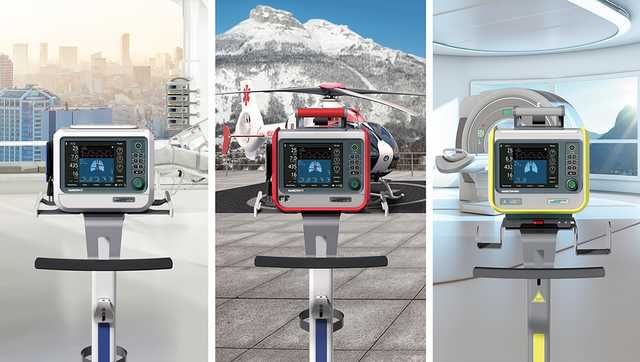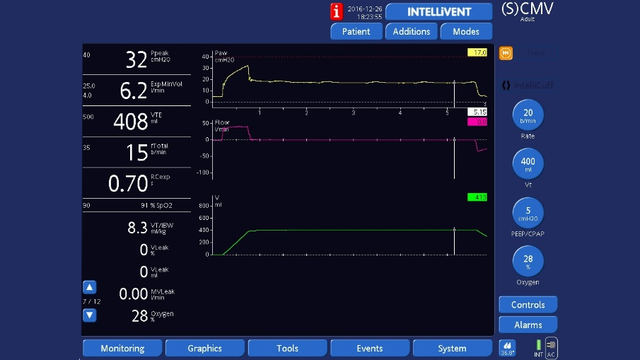
Autore: Simon Franz
Data: 14.07.2017

Background
Anche se il principio di una pressione di plateau "sicura" è già stato messo in discussione, gli standard di cura ne prevedono ancora l'utilizzo per l'adeguamento della ventilazione con protezione polmonare nei pazienti con distress respiratorio acuto (ARDS) (
Visualizzazione di Pplateau come parametro di monitoraggio
A causa del sistema pneumatico senza valvole, sui ventilatori HAMILTON‑C1/T1/MR1 non è possibile misurare Pplateau eseguendo una manovra di pausa inspiratoria. Pplateau è comunque disponibile come parametro di monitoraggio e può essere visualizzata se il software del ventilatore utilizzato lo consente.
| HAMILTON‑C1/T1/MR1, versione software < 2.2.0 | HAMILTON‑C1/T1/MR1, versione software ≥ 2.2.0 |
|---|---|
| La pressione di fine inspirazione è sempre visualizzata come Pplateau. Occorre ricordare che se è presente un flusso a fine espirazione il valore di Pplateau visualizzato è superiore al valore effettivo di Pplateau. | Il valore di Pplateau viene visualizzato solo se il flusso a fine espirazione è prossimo allo zero. Il valore di Pplateau visualizzato può comunque essere maggiore del valore effettivo di Pplateau. |
Calcolo di Pplateau con flusso a fine espirazione non prossimo a zero
Di sequito una potenziale strategia alternativa per calcolare Pplateau nelle situazioni in cui il flusso a fine inspirazione non è vicino allo zero o la pressione di fine inspirazione misurata non sembra accurata:
- Calcolare la driving pressure (∆P): ∆P = VTE/Cstat
- Calcolare Pplateau: Pplateau = ∆P + PEEP
Questo calcolo dipende dall'accuratezza del valore misurato di Cstat, ovvero dall'assenza di sforzi significativi del paziente. Pinsp deve essere almeno ~10 cmH2O.
Pplateau = (VTE ml/Cstat ml/cmH2O) + PEEP cmH2O
Esempio
VTE: 450 ml; Cstat: 50 ml/cmH2O; PEEP: 8 cmH2O
(450 ml/50 ml/cmH2O) + 8 cmH2O = 17 cmH2O
Pplateau = 17 cmH2O
∆P = 9 cmH2O
Un ulteriore vantaggio è dato dal fatto che dal calcolo si ottiene anche ∆P. ∆P è fortemente associata alla sopravvivenza nei pazienti con ARDS e può quindi rivelarsi il parametro più interessante (
Dispositivi interessati: HAMILTON‑C1/T1/MR1 (tutte le versioni software)
Note
Bibliografia
- 1. Loring SH, Weiss JW. Plateau pressures in the ARDSnet protocol: cause of injury or indication of disease?. Am J Respir Crit Care Med. 2007;176(1):99‑101. doi:10.1164/ajrccm.176.1.99b
- 2. Amato MB, Meade MO, Slutsky AS, et al. Driving pressure and survival in the acute respiratory distress syndrome. N Engl J Med. 2015;372(8):747‑755. doi:10.1056/NEJMsa1410639
Related articles. Get a deeper look

Driving pressure in ARDS patients
ARDS is characterized by lung collapse and consolidation leaving just a small portion of aerated lung remaining, which is at risk of ventilator‑induced lung injuries (baby‑lung concept).

How to measure driving pressure
Airway driving pressure is associated with clinical outcomes in ARDS, post‑surgical, and normal‑lung patients, and is a measure of the strain applied to the respiratory system and the risk of ventilator‑induced lung injuries. Evidence suggests we should keep driving pressure below 14 cmH2O. But how can we measure it?


